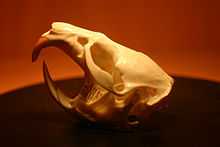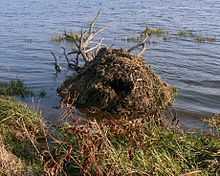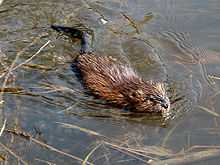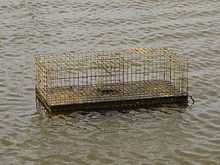Muskrat
| Muskrat Temporal range: Recent | |
|---|---|
 | |
| A muskrat foraging near a spring at Onondaga Cave State Park in Missouri | |
| Conservation status | |
| Scientific classification | |
| Kingdom: | Animalia |
| Phylum: | Chordata |
| Class: | Mammalia |
| Order: | Rodentia |
| Superfamily: | Muroidea |
| Family: | Cricetidae |
| Subfamily: | Arvicolinae |
| Tribe: | Ondatrini Gray, 1825 |
| Genus: | Ondatra Link, 1795 |
| Species: | O. zibethicus |
| Binomial name | |
| Ondatra zibethicus (Linnaeus, 1766) | |
 | |
| Muskrat range (native range in red, introduced range in green. Native range in Newfoundland and Introduced range in South America not shown.) | |
The muskrat (Ondatra zibethicus), the only species in genus Ondatra and tribe Ondatrini, is a medium-sized semiaquatic rodent native to North America, and introduced in parts of Europe, Asia, and South America. The muskrat is found in wetlands over a wide range of climates and habitats. It has important effects on the ecology of wetlands[2] and is a resource of food and fur for humans. It is an introduced species in some of its present range.
The muskrat is the largest species in the subfamily Arvicolinae, which includes 142 other species of rodents, mostly voles and lemmings. Muskrats are referred to as "rats" in a general sense because they are medium-sized rodents with an adaptable lifestyle and an omnivorous diet. They are not, however, so-called "true rats", that is, members of the genus Rattus.
Etymology
The muskrat's name probably comes by folk etymology from a word of Algonquin origin, muscascus, (literally "it is red", so called for its colorings) or from the Abenaki native word mòskwas as seen in the archaic English name for the animal, musquash. Because of the association with the "musky" odor, which the muskrat uses to mark its territory, and its flattened tail the name became altered to musk-beaver;[3] later it became muskrat due to its resemblance to rats.[4][5][6]
Description
An adult muskrat is about 40–70 cm (16–28 in) long, half of that is the tail, and weighs from 0.6–2 kg (1.3–4.4 lb).[7] That is about four times the weight of the brown rat (Rattus norvegicus), though an adult muskrat is only slightly longer. Muskrats are much smaller than beavers (Castor canadensis), with whom they often share their habitat.[4][5]

Muskrats are covered with short, thick fur which is medium to dark brown or black in color, with the belly a bit lighter; as the age increases, it turns a partly gray in color. The fur has two layers, which helps protect them from the cold water. They have long tails covered with scales rather than hair and, to aid them in swimming, are slightly flattened vertically,[8] which is a shape that is unique to them.[9] When they walk on land, their tails drag on the ground, which makes their tracks easy to recognize.[4][5]
Muskrats spend much of their time in the water and are well suited for their semiaquatic life. They can swim under water for 12 to 17 minutes. Their bodies, like those of seals and whales, are less sensitive to the buildup of carbon dioxide than those of most other mammals. They can close off their ears to keep the water out. Their hind feet are semiwebbed, although in swimming, their tails are their main means of propulsion.[10]
Distribution and ecology

Muskrats are found over most of Canada and the United States and a small part of northern Mexico. They were introduced to Europe in the beginning of the 20th century. They mostly inhabit wetlands, areas in or near saline and freshwater wetlands, rivers, lakes, or ponds. They are not found in the state of Florida, where the round-tailed muskrat, or Florida water rat (Neofiber alleni), fills their niche.[4]
Their populations naturally cycle; in areas where they become abundant, they are capable of removing much of the vegetation in wetlands.[11] They are thought to play a major role in determining the vegetation of prairie wetlands in particular.[12] They also selectively remove preferred plant species, thereby changing the abundance of plant species in many kinds of wetlands.[2] Species commonly eaten include cattail and yellow water lily. Alligators are thought to be an important natural predator, and the absence of muskrats from Florida may in part be the result of alligator predation.[13]
While much wetland habitat has been eliminated due to human activity, new muskrat habitat has been created by the construction of canals or irrigation channels, and the muskrat remains common and widespread. They are able to live alongside streams which contain the sulfurous water that drains away from coal mines. Fish and frogs perish in such streams, yet muskrats may thrive and occupy the wetlands. Muskrats also benefit from human persecution of some of their predators.[5]
The muskrat is classed as a "prohibited new organism" under New Zealand's Hazardous Substances and New Organisms Act 1996, preventing it from being imported into the country.[14]
Behavior

Muskrats normally live in groups consisting of a male and female pair and their young. During the spring, they often fight with other muskrats over territory and potential mates. Many are injured or killed in these fights. Muskrat families build nests to protect themselves and their young from cold and predators. In streams, ponds or lakes, muskrats burrow into the bank with an underwater entrance. These entrances are 6–8 inches wide. In marshes, push-ups are constructed from vegetation and mud. These push-ups are up to three feet in height. In snowy areas, they keep the openings to their push-ups closed by plugging them with vegetation, which they replace every day. Some muskrat push-ups are swept away in spring floods and have to be replaced each year. Muskrats also build feeding platforms in wetlands. They help maintain open areas in marshes, which helps to provide habitat for aquatic birds.[5][15]
Muskrats are most active at night or near dawn and dusk. They feed on cattails and other aquatic vegetation. They do not store food for the winter, but sometimes eat the insides of their push-ups. While they may appear to steal food beavers have stored, more seemingly cooperative partnerships with beavers exist, as featured in the BBC David Attenborough wildlife documentary The Life of Mammals.[16][17] Plant materials make up about 95% of their diets, but they also eat small animals, such as freshwater mussels, frogs, crayfish, fish, and small turtles.[4][5] Muskrats follow trails they make in swamps and ponds. When the water freezes, they continue to follow their trails under the ice.

Muskrats provide an important food resource for many other animals, including mink, foxes, coyotes, wolves, lynx, bears, eagles, snakes, alligators, and large owls and hawks. Otters, snapping turtles, and large fish such as pike prey on baby muskrats. Caribou and elk sometimes feed on the vegetation which makes up muskrat push-ups during the winter when other food is scarce for them . In their introduced range in the former Soviet Union, the muskrat's greatest predator is the golden jackal. They can be completely extirpated in shallow water bodies, and during the winter of 1948–49 in the Amu Darya, muskrats constituted 12.3% of jackal faeces contents, and 71% of muskrat houses were destroyed by jackals, 16% of which froze and became unsuitable for muskrat occupation. Jackals also harm the muskrat industry by eating muskrats caught in traps or taking skins left out to dry.[18]
Muskrats, like most rodents, are prolific breeders. Females can have two or three litters a year of six to eight young each. The babies are born small and hairless, and weigh only about 22 grams (0.8 oz). In southern environments, young muskrats mature in six months, while in colder northern environments, it takes about a year. Muskrat populations appear to go through a regular pattern of rise and dramatic decline spread over a six- to 10-year period. Some other rodents, including famously the muskrat's close relatives the lemmings, go through the same type of population changes.
In human history
_fur_backs%2C_jacket.jpg)
Native Americans have long considered the muskrat to be a very important animal. Some predict winter snowfall levels by observing the size and timing of muskrat lodge construction.[19]
In several Native American creation myths, it is the muskrat that dives to the bottom of the primordial sea to bring up the mud from which the earth is created, after other animals have failed in the task.[20]
Muskrats have sometimes been a food resource for humans. In the southeastern portion of Michigan, a longstanding dispensation allows Catholics to consume muskrat on Ash Wednesday and on Lenten Fridays (when the eating of meat, except for fish, is prohibited); this tradition dates back to at least the early 19th century.[21]

Muskrat fur is warm, becoming prime at the beginning of December in northern North America. In the early 20th century, the trapping of the animal for its fur became an important industry there. During that era, the fur was specially trimmed and dyed to be sold widely in the US as "hudson seal" fur.[22] Muskrats were introduced at that time to Europe as a fur resource, and spread throughout northern Europe and Asia.
In some European countries, such as Belgium and the Netherlands, the muskrat is considered a pest, as its burrowing damages the dikes and levees on which these low-lying countries depend for protection from flooding. In those countries it is trapped and hunted to keep the population down. Muskrats also eat corn and other farm and garden crops growing near water bodies.[5] The Royal Canadian Mounted Police winter hats are made from muskrat fur,[23] a practice that has been strongly opposed by numerous animal welfare groups, including the Association for the Protection of Fur-Bearing Animals.[24]
References
- ↑ Linzey, A.V. (2008). Ondatra zibethicus. In: IUCN 2008. IUCN Red List of Threatened Species. Retrieved 10 Jule 2009. Database entry includes a brief justification of why this species is of least concern.
- ↑ 2.0 2.1 Keddy, P.A. 2010. Wetland Ecology: Principles and Conservation (2nd edition). Cambridge University Press, Cambridge, UK.
- ↑ Hearne, Samuel. (1745–1792) A Journey to the Northern Ocean: The Adventures of Samuel Hearne. Surrey, BC: TouchWood Editions.
- ↑ 4.0 4.1 4.2 4.3 4.4 Caras, R. 1967. North American Mammals. New York: Galahad Books. ISBN 0-88365-072-X
- ↑ 5.0 5.1 5.2 5.3 5.4 5.5 5.6 Nowak, R. & Paradiso, J. 1983. Walker's Mammals of the World. Baltimore, Maryland: The Johns Hopkins University Press. ISBN 0-8018-2525-3
- ↑ "Muskrat". Merriam-Webster Dictionary. Merriam-Webster. October 2, 2011. Retrieved October 2, 2011.
- ↑ Burnie D and Wilson DE (Eds.), Animal: The Definitive Visual Guide to the World's Wildlife. DK Adult (2005), ISBN 0789477645
- ↑ Wildlife Directory: Muskrat – Living with Wildlife – University of Illinois Extension. M.extension.illinois.edu. Retrieved on 2012-12-20.
- ↑ Muskrats. Library.csi.cuny.edu. Retrieved on 2012-12-20.
- ↑ Voelker, W. 1986. The Natural History of Living Mammals. Medford, New Jersey: Plexus Publishing, Inc. ISBN 0-937548-08-1
- ↑ O’Neil, T. (1949). The Muskrat in the Louisiana Coastal Marshes. New Orleans, LA: Louisiana Department of Wildlife and Fisheries.
- ↑ van der Valk, A. G. (1989). Northern Prairie Wetlands. Ames, IA: Iowa State University Press.
- ↑ Keddy, P. A., Gough, L., Nyman, J. A., McFalls, T., Carter, J., and Siegnist, J. (2009). Alligator hunters, pelt traders, and runaway consumption of Gulf Coast marshes: a trophic cascade perspective on coastal wetland losses. In Human Impacts on Salt Marshes: A Global Perspective, eds. B. R. Silliman, E. D. Grosholz, and M. D. Bertness, pp. 115–133. Berkeley, CA: University of California Press.
- ↑ "Hazardous Substances and New Organisms Act 2003 – Schedule 2 Prohibited new organisms". New Zealand Government. Retrieved 26 January 2012.
- ↑ Attenborough, D. 2002. The Life of Mammals. Princeton, New Jersey: Princeton University Press. ISBN 0-691-11324-6
- ↑ Attenborough, David. 2002. The Life of Mammals, Episode 4. BBC Video.
- ↑ The Life of Mammals#4. "Chisellers"
- ↑ Mammals of the Soviet Union Vol. II Part 1a, "Sirenia and Carnivora" (Sea cows; Wolves and Bears), V.G. Heptner and N.P. Naumov (eds.), Science Publishers, Inc. USA. 1998. ISBN 1-886106-81-9
- ↑ Smith, Murray (May 1982). "Science for the Native Orientated Classroom". Journal of American Indian Education 21 (1). Retrieved 2010-01-08.
- ↑ Musgrave, P. 2007. "How the Muskrat Created the World" Muskrat.com Accessed November 11, 2007.
- ↑ Kristin Lukowski (March 8, 2007), "Muskrat love: Friday Lent delight for some OKed as fish alternative", Catholic News Service (Catholic Online), retrieved March 31, 2013
- ↑ Ciardi, J. 1983. On Words. Weekly broadcast on NPR.
- ↑ "RCMP Muskrat Hat"
- ↑ "Association for the Protection of Fur-Bearing Animals"
External links
| Wikispecies has information related to: Ondatra |
| Wikimedia Commons has media related to Ondatra zibethicus. |
- "Ondatra zibethicus". Integrated Taxonomic Information System. Retrieved 23 March 2006.
- Everything Muskrat
- How the Muskrat Became a Fish
- How Muskrat Created the World – Native American Legends
- The New Student's Reference Work/Muskrat
| |||||||||||||||||||||||||||||||||||||||||||||||||||||||||||||||||||||||||||||||||||||||||||||||||||||||||||||||
